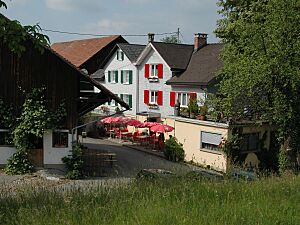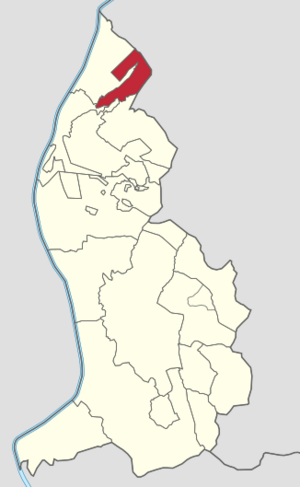Schellenberg facts for kids
Quick facts for kids
Schellenberg
|
|||
|---|---|---|---|
|
Municipality
|
|||

Schellenberg in early-June 2007
|
|||
|
|||
|
Location of Schellenberg
|
|||

Schellenberg within Liechtenstein
|
|||
| Country | |||
| Electoral district | Unterland | ||
| Villages | Hinterschellenberg | ||
| Area | |||
| • Total | 3.5 km2 (1.4 sq mi) | ||
| Elevation | 626 m (2,054 ft) | ||
| Population
(31-12-2019)
|
|||
| • Total | 1,107 | ||
| • Density | 294/km2 (760/sq mi) | ||
| Time zone | UTC+1 (CET) | ||
| • Summer (DST) | UTC+2 (CEST) | ||
| Postal code |
9488
|
||
| Area code(s) | 7011 | ||
| ISO 3166 code | LI-08 | ||
| Website | www.schellenberg.li | ||
Schellenberg (German pronunciation: [ˈʃɛlənˌbɛʁk]) is a municipality in the lowland area of Liechtenstein, on the banks of the Rhine. As of 2019[update], it has a population of 1,107 and covers an area of 3.5 km2 (1.4 sq mi)
Contents
History
Early history
The area was first settled by Celts, then by Rhaetians. Rome conquered the area in 15 BC, and made it part of the province of Rhaetia. The Province later became a county (countship) under Charlemagne. The county was repeatedly divided among heirs.
The Lordship of Schellenberg was purchased by the Counts of Vaduz in 1437 and the two states have been united in fact ever since. After the Swabian War in 1499, both came under Austrian suzerainty. Different dynasties of counts bought and sold them, until their purchase in the early 18th century by the Liechtenstein dynasty, which had been granted princely status in 1706, but which needed to acquire a territory with imperial immediacy in order to vote in the Diet of the Princes of the Empire. The emperor formally united Vaduz and Schellenberg in 1719 as the Principality of Liechtenstein.
World War II
The Russian Monument, located in Hinterschellenberg, in the municipality commemorates the asylum given to Russian soldiers during the Second World War. Near the end of World War II, Liechtenstein granted asylum to approximately five hundred soldiers of the First Russian National Army, a collaborationist Russian force within the German Wehrmacht. This act was no small matter, as the country was poor and had difficulty feeding and caring for such a large group of refugees. Eventually, Argentina agreed to resettle the asylum seekers permanently. In contrast, the British repatriated the Russians who fought on the German side to the USSR.
Administration
Schellenberg is administered by the mayor and a 9-person municipal council, elected every four years since 1975. The incumbent mayor is Dietmar Lampert, since 2023.
List of mayors (1864–present)
| Name | Term | Party | Ref(s). | |
|---|---|---|---|---|
| Johann Hassler | 1864–1867 |
|
||
| Josef Kaiser | 1867–1870 | |||
| Meinrad Marxer | 1870–1873 | |||
| Josef Kaiser | 1873–1876 | |||
| Meinrad Marxer | 1876–1885 | |||
| Elias Oehri | 1885–1888 | |||
| Meinrad Marxer | 1888–1891 | |||
| Matthäus Wohlwend | 1891–1894 | |||
| Ludwig Elkuch | 1894–1909 | |||
| Andreas Hassler | 1909–1915 | |||
| Karl Kaiser | 1915–1927 | Progressive Citizens' Party | ||
| Adolf Goop | 1927–1933 | Patriotic Union | ||
| Philipp Elkuch | 1933–1945 | Progressive Citizens' Party | ||
| Urban Rederer | 1945–1954 | Patriotic Union | ||
| Georg Oehri | 1954–1960 | Progressive Citizens' Party | ||
| Hugo Oehri | 1960–1972 | |||
| Hermann Hassler | 1972–1979 | Patriotic Union | ||
| Edgar Elkuch | 1979–1987 | Progressive Citizens' Party | ||
| Walter Kieber | 1987–2003 | Patriotic Union | ||
| Norman Wohlwend | 2003–2023 | Progressive Citizens' Party | ||
| Dietmar Lampert | 2003–present | Patriotic Union | ||
Geography
Schellenberg territory borders with the Liechtensteiner municipalities of Eschen, Gamprin, Mauren and Ruggell. It borders also with the Austrian municipality of Feldkirch, in the federal state of Vorarlberg.
Transport
In Schellenberg there is a small road crossing to Austria, manned by Austrian and Swiss border guards.
Notable people
- Gisela Biedermann, physician and politician
- Julia Hassler, Olympic swimmer.
- Fabienne Wohlwend, motor racing driver.
See also
 In Spanish: Municipio de Schellenberg para niños
In Spanish: Municipio de Schellenberg para niños


